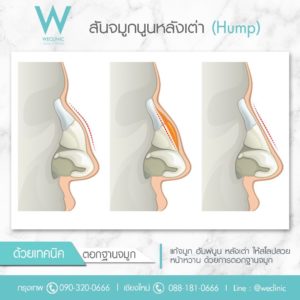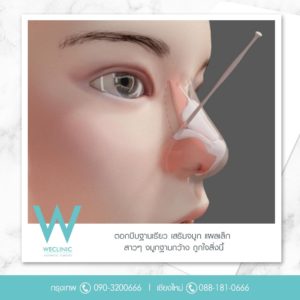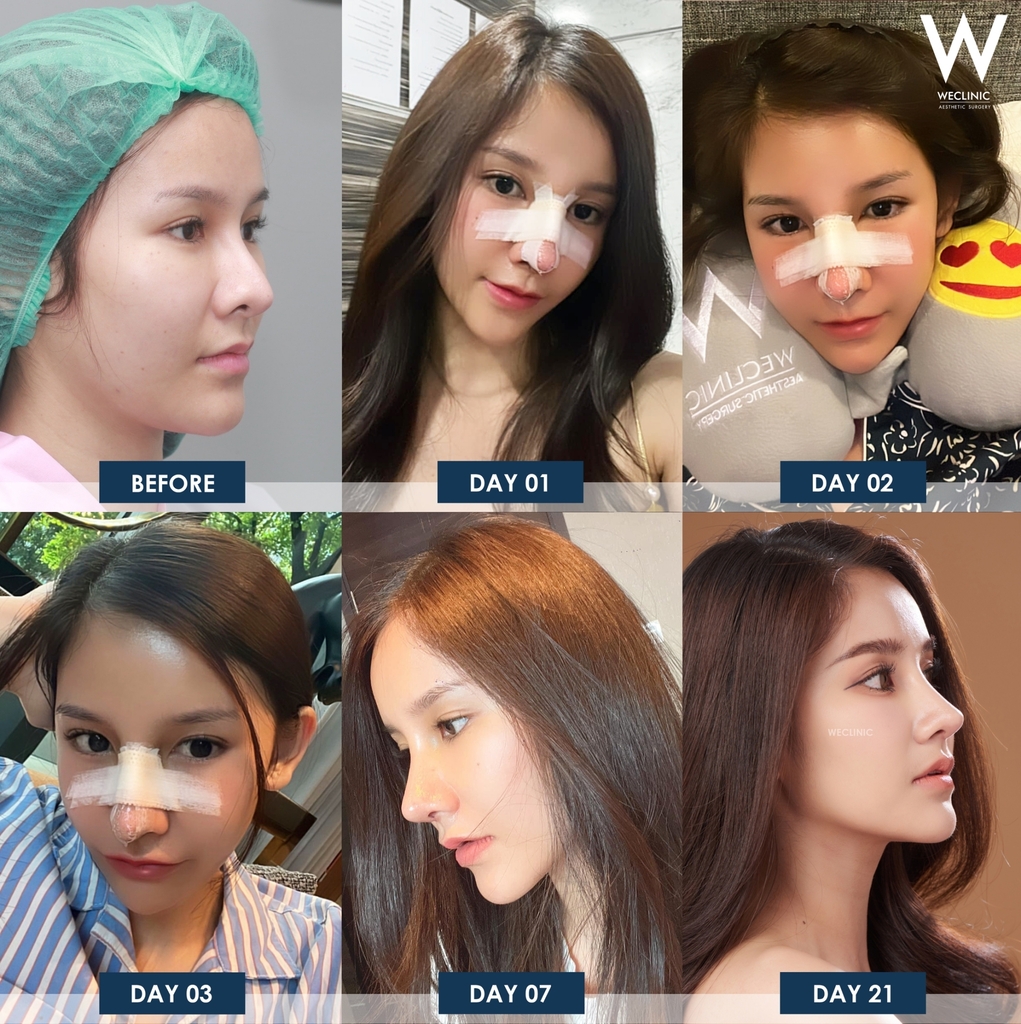Nose Augmentation & Nose Osteotomy
Have you heard about nose osteotomy before? Chances are, many of you have. Still, some may be wondering what exactly this technique does, and how does it improve the results of a nose job?
At WE Clinic, we’re here to clear up any confusion and explain everything you need to know about this powerful surgical technique. In this article, we’ll walk you through what a nose osteotomy actually is, when it’s used, and how it can reshape a wide nasal base for a more balanced, refined look. You’ll also find essential post-op care tips and expert advice—so don’t miss a single word if you’re planning to enhance your nose!

What Is Nose Osteotomy?
Nose osteotomy is a specialized surgical technique that involves reshaping the nasal bone using precise instruments to narrow or reposition the nasal bridge. It allows for more refined and aesthetically pleasing nose shapes such as a natural contour or a gently sloped, defined tip without leaving visible scars on the face.
This procedure is especially beneficial for individuals with a wide nasal base, asymmetrical nasal bones, prominent nasal humps, congenital deformities, or post-traumatic nasal misalignment. Nose osteotomy also enhances the effectiveness of silicone implants during augmentation, reducing the risk of implant shifting or crooked results. The outcome is a more balanced and harmonious nasal structure overall.
For those who are just starting to learn about nose surgery, Dr. Sam has written a detailed guide in the article:
“Slope Nose Augmentation: How to Prepare, What It Costs, and Real Patient Reviews.”
Another helpful summary for beginners can be found in:
“Nose Augmentation & Revision: Prices, Facial Harmony Tips, and How to Enhance Your Luck with a Beautiful Nose – 2023.”

(Humpectomy)
Are the Benefits of Nose Osteotomy?
Nose osteotomy, also known as osteotomy-assisted rhinoplasty, is a specialized technique that significantly enhances the success of nose surgery. By reshaping the nasal base especially in cases where the bones are crooked or asymmetrical—this method helps create a more stable foundation for silicone implants, resulting in a refined, well-balanced nose shape that aligns with your desired look.
More importantly, it helps reduce common post-surgery issues such as implant displacement, visible implant edges, or a crooked appearance after augmentation.
In addition, properly adjusting the nasal base allows the surgeon to control the width of the nasal bridge, creating smoother contours that flow naturally from the eyebrows to the nose tip. This results in a flatter, more elegant nose bridge that enhances facial harmony making your overall appearance softer and more delicate.
Refine a Wide Nose Using the Nose Osteotomy Technique
Who Is Nose Osteotomy Recommended For?
Nose osteotomy is suitable for individuals with the following nasal characteristics:
- A wide nasal base that extends beyond the inner corners of the eyes, creating a flared appearance
- A prominent nasal hump (raised bony bump along the nasal bridge)
- A deviated or crooked nasal bridge
For those with a nasal hump or an imbalanced nasal bone structure who wish to lengthen or raise the height of their nose through augmentation, combining silicone implants with a base osteotomy is often necessary.
If the implant is placed without correcting the underlying bone structure, it may not sit flush against the nasal base and could eventually lead to complications like implant visibility or displacement.
Types of Nose Osteotomy Techniques
Nose osteotomy differs from standard rhinoplasty because it focuses on reshaping the nasal structure to achieve a natural, refined look without leaving visible scars. There are three main techniques used in nose osteotomy:
1. Open Nose Reconstruction (Open Technique)
This approach involves fully opening the nose during surgery, allowing the surgeon to clearly see the nasal structure. It makes the osteotomy process more precise and effective—especially for patients with severely deviated nasal bridges, large humps, or wide nasal bases. Once the osteotomy is completed, the surgeon can align the nose before placing the implant.
2. Closed Nose Reconstruction (Closed Technique)
In this method, small incisions are made inside one or both nostrils. Specialized instruments are inserted through the same incision used for rhinoplasty. Since there are no external scars, this technique is best suited for patients with wide noses or nasal bases that extend beyond the inner corners of the eyes, but without significant nasal deviation.
3. External Lateral Osteotomy
This technique targets the sides of the nasal bridge. Instruments are used to narrow and symmetrize the nasal base by carefully breaking and repositioning the bones from the outside. It involves two small incisions (around 2–3 mm) on each side of the nose
Nose osteotomy is suitable for correcting the following nasal issues:
1.Hump nose
What Is a Nasal Hump?
A nasal hump refers to a noticeable bump or elevation along the bridge of the nose. It’s often visible when viewed from the side or when touched, as the surface feels uneven. In some individuals, a prominent nasal hump can cause the nose to appear crooked or off-center. It is also commonly associated with a drooping nose tip, which can make the face look older or overly stern.
How to Correct a Nasal Hump?
If the nasal hump is minor and not too raised, it can be corrected by rasping the bone to smooth out the nasal bridge.However, if the hump is large, the bone is highly elevated, or the nasal base is wide, a humpectomy is recommended.
In cases like this, the surgeon will use specialized tools to remove the excess bone and refine the nasal base to create a smoother contour.
A silicone implant is then shaped to fit the newly adjusted bone structure adding height while helping to conceal any remaining unevenness along the nasal bridge.
Preferred Surgical Approach
At WE Clinic, surgeons often choose to perform nasal hump removal (humpectomy) in combination with open nose reconstruction.
This open technique allows for full visibility of the underlying nasal structure—especially when the bones are raised, crooked, or asymmetrical. By clearly identifying the problem areas, the surgeon can perform the osteotomy with precision.
Once the excess bone is removed, the nasal base is then rasped and smoothed. The prominent hump is permanently corrected, ensuring that the nose will not return to its previous crooked or arched shape.
Results:
The nasal bridge appears more sloped and smoother, with no noticeable hump.
The area between the eyes becomes gently curved, giving the face a softer and more delicate look.
It also corrects the crookedness of the nasal base, making it suitable for precise silicone implant placement and a well-fitted nasal bridge augmentation.
2. Wide Nasal Bridge – Structured from the Side, but Flat from the Front
What Causes a Prominent Nasal Bridge?
A prominent nasal bridge is often the result of large nasal bones on both sides of the nose.
You can check this by gently placing your fingers on the sides of your nasal bridge or next to your silicone implant.
If you feel that the base in this area is wide, firm, and close to the inner corners of your eyes, it may indicate the need for correction.
How to Correct a Wide Nose with a Large Nasal Base?
This can be corrected using a narrowing osteotomy technique.At WE Clinic, the surgeon typically creates two tiny incisions just about 2 mm in size on the skin along each side of the nasal bridge.Through these incisions, fine surgical instruments are inserted to carefully fracture the overly wide nasal bone, creating a controlled break.The bones are then gently pressed inward, allowing the nasal base to narrow and the nose to appear slimmer and more refined.

Commonly Used Method:
This procedure can be performed using either the closed technique or the open (open-recon) technique, as small incisions can be made directly along the skin beside the nasal bridge.In cases combined with nose reconstruction that includes humpectomy and base osteotomy, the slimming effect can be even more pronounced.
The more osteotomy lines are made, the slimmer the nose becomes.
Results:
The nasal bridge appears slimmer and more defined, no longer overly wide or blocky.
The slope of the nose can also be adjusted to better complement the patient’s facial features.
During the first three months after nasal osteotomy, the bones may not have fully settled into place.In some cases, the surgeon may recommend that patients use gentle manual compression with their fingers to help shape the nasal base and encourage better contouring.
Preoperative Preparation for Nose Osteotomy
Are you about to undergo a nose osteotomy? Or are you still researching whether it’s right for you? One important thing not to overlook is how to properly prepare before the procedure. Here’s a checklist to help guide you:
- Research nose osteotomy thoroughly and consult a doctor about your specific concerns and the results you want to achieve
- Meet with an experienced surgeon to evaluate your facial structure and determine if osteotomy is the right approach for your condition
- Inform your doctor about any allergies (food or medication) and underlying medical conditions
- Get adequate rest and sleep before surgery
- Stop taking vitamins, dietary supplements, and avoid alcohol and smoking for about 1 month prior to surgery
- Avoid medications that affect blood clotting, such as aspirin, for about 1 month before surgery
- Refrain from drinking tea or coffee 1 day before the procedure
- Avoid foods that may cause inflammation, such as fermented foods, seafood, or any known irritants, unless necessary

Step-by-Step Procedure for Closed Nose Osteotomy
When using the open technique, the nose is fully opened, allowing the surgeon to clearly see the entire nasal structure. This makes osteotomy relatively straightforward.
However, in this article, we’ll focus on the closed technique, which is more complex since the internal structure is not fully visible. The closed osteotomy procedure typically involves 7 steps:
- Local anesthesia is administered, and the surgeon waits for it to take full effect.
- Small incisions are made inside both nostrils, followed by creating a pocket beneath the lower nasal cartilage (subperichondrial dissection).
- A space is carefully created beneath the upper nasal bone (subperiosteal dissection), adjusted based on the shape and size of the nasal bones and the flexibility of the patient’s skin.
- Specialized instruments are inserted to perform the lateral osteotomy on both sides of the nasal base, improving symmetry.
- The nasal bones are manually compressed inward to reduce the base width. The area is then refined to achieve a smoother, sloped nasal bridge. A nasal splint may be applied post-surgery to support the repositioned bones.
- A custom-shaped silicone implant is inserted beneath the bone lining and adjusted until it fits perfectly.
- The incisions are closed with sutures.
Where Should You Get a Nose Osteotomy?
Not all clinics or hospitals can deliver perfect results. Choosing the right place for a nose osteotomy is just as important as the surgery itself. If you want stunning, natural-looking results, you need to be selective.
Here are some helpful tips from WE Clinic on what to look for:
- Choose a certified clinic or hospital that meets safety standards and has an official 11-digit medical license
- Ensure the facility is equipped with modern tools and up-to-date medical technology
- The environment must be clean, sterile, and infection-free
- The procedure should be performed by a qualified and experienced surgeon specializing in nose augmentation and osteotomy
- The surgeon’s name should be verifiable through the official Thai Medical Council website
- A thorough consultation and honest evaluation by a medical professional should be provided beforehand
- The location should be easily accessible and convenient for travel
- There should be genuine reviews from real patients, including written feedback and before-and-after photos of osteotomy procedures
- Pricing should be reasonable not suspiciously cheap
How Much Does a Nose Osteotomy Cost?
| Nose Augmentation | Price List: |
| Special closed revision rhinoplasty with osteotomy | Starting from 49,000 THB |
| Open rhinoplasty with structural reconstruction osteotomy and septum extension | Starting from 79,000 THB |
How much does nose surgery cost? What are the prices for each technique? Why do the prices vary?
Find the answers here: Nose Surgery Price Guide Which Technique Should You Choose? What’s the Difference Between Expensive and Affordable Options?
How to Take Care After a Nose Osteotomy?
Post-operative care for a nasal osteotomy is similar to that of a standard rhinoplasty.
- Cold Compress: In the first 72 hours after surgery, apply a cold compress to both sides of the nasal bridge for 5–10 minutes every hour. Frequent cold compresses help stop bleeding and significantly reduce swelling.
- Warm Compress (after 72 hours): If mild bruising appears after 72 hours, this is considered normal.
- The WE Clinic recommends switching to a warm compress on both sides of the nose.
- Soak the compress gel in hot water until it’s warm (not too hot), and wrap it in a thin cloth before applying it to the skin.
- Caution: Avoid excessive heat, as it may cause burns.
Post-Operative Care After Rhinoplasty and Nose Osteotomy
If you’ve recently undergone rhinoplasty or a nasal osteotomy, here’s how to take care of yourself for optimal recovery:
- Avoid inflammatory foods that may increase swelling, such as seafood, fermented foods, spicy dishes, and allergy-triggering items.
- Do not eat hard or chewy foods that require excessive chewing, as this may disrupt the surgical site.
- Drinking coconut water or centella asiatica (gotu kola) juice may reduce swelling and bruising naturally.
- Use cold compresses during the initial phase to help minimize swelling and discomfort.
- For the first month, sleep with your head upright using a high pillow. Avoid sleeping on your sides to prevent the implant from shifting.
- In the first 3 days, keep the surgical wound clean regularly to reduce the risk of infection.
- Avoid scratching or picking at the wound. If it feels itchy, apply an ointment around the area instead.
- Avoid wearing glasses or engaging in strenuous physical activity for at least one month.
- If you catch a cold or have a runny nose, take antihistamines and keep nasal secretions away from the wound. See a doctor if symptoms persist.
- If a nasal splint was used, it can typically be removed by yourself after 7 days.
- A proper diet plays a crucial role in wound recovery.
For more info on post-op nutrition, read: “What to Eat After Rhinoplasty: Complete Food Guide for Faster Healing”

Is Nose Osteotomy Dangerous? What Should You Be Aware Of?
Many people wonder whether nose osteotomy is dangerous, especially since the procedure involves creating small fractures in the nasal bones to narrow the bridge.
In fact, when performed by an experienced surgeon, nose osteotomy is considered safe. However, it may involve some side effects, such as nose bleeding and more swelling or bruising compared to regular rhinoplasty. This is because the nasal bones are repositioned, leaving a temporary gap between the nasal bridge and facial bones.
To help stabilize the new shape, a nasal splint is usually worn for the first 7 days. Over the next 6 months, the bones will gradually fuse back together naturally.
Nose Osteotomy Review
If you’re considering nose augmentation but are concerned about having a wide nasal base, asymmetry, or crooked nasal structure, you might be wondering whether a nose osteotomy is the right choice. Will it really help refine your nose shape? Can it correct structural issues effectively?
Take a look at real patient reviews from We Clinic who underwent rhinoplasty combined with a nasal osteotomy. These testimonials can help guide your decision and give you a clearer idea of what to expect.
Explore more reviews from We Clinic’s expert surgeons here: Nose Augmentation Reviews – Natural results that suit your facial structure, beyond expectations.


Nose Osteotomy Without Silicone Implant
In open rhinoplasty (open technique), it’s possible to perform a nose osteotomy without using a silicone implant. Instead of inserting silicone, the surgeon may use autologous grafts such as rib cartilage to enhance nasal height while simultaneously reshaping the bone structure through osteotomy. This technique allows for a more natural result while avoiding synthetic materials.
Frequently Asked Question:
How long does it take to recover from a nose osteotomy?
After a nasal osteotomy, it usually takes around 1 to 3 months for the nose to begin settling into its new shape. However, if the osteotomy is performed as part of an open rhinoplasty, it may take 6 to 12 months for the final results to become fully apparent.
During the first 3 months, patients can gently press and massage the nasal base with their fingers to help the nose shape settle more quickly.
Do I need to choose the type of nose osteotomy myself?
Not at all. You don’t need to know the specific technical details in advance. At WE Clinic, both Dr. Sam and Dr. Da carefully assess the nasal structure of every patient before surgery.
They will explain the necessary techniques to be used during your procedure such as the number of osteotomy lines, types of bone cuts, or whether to combine the procedure with an ear cartilage graft or open rhinoplasty.
The approach is always customized based on the patient’s facial structure and concerns.
So, in most cases, it’s the specialist surgeon who decides on the best osteotomy technique for you.
Will I experience swelling or bruising after surgery?
Swelling and bruising from nasal bone osteotomy are generally similar to regular rhinoplasty cases.To help reduce postoperative symptoms more quickly, it’s recommended to apply cold compresses to both sides of the nasal bridge, avoid inflammatory foods, smoking, and alcohol.These practices can significantly minimize swelling and bruising after surgery.
When will the stitches be removed after a nose osteotomy?
Your doctor will schedule stitch removal around 7-14 days after the surgery.By this time, the wound has usually begun to heal well.
To help the incision heal completely and fade more quickly, it’s recommended to apply scar-reducing ointment regularly after the stitches are removed. With proper care, the scar often fades without leaving a visible mark.
Does a nose osteotomy hurt?
During the nose osteotomy procedure, you won’t feel any pain because local anesthesia will be administered to numb the area.
This ensures that the entire procedure is pain-free.
However, once the anesthesia wears off, you may experience some soreness, swelling, or bruising.
These symptoms can be relieved with cold compresses, which will help reduce discomfort and promote faster recovery.
Summary
Nasal osteotomy is a highly effective rhinoplasty technique that addresses a wide range of nasal structure issues.
It can correct concerns such as a crooked nose, deviated nasal bridge, wide or humped nasal dorsum, and even trauma-induced nasal deformities.
One of the major advantages of this technique is that it typically leaves minimal to no visible scarring on the face, as the incisions are very small.
Once healed, the nose appears more refined and balanced, boosting overall facial harmony and self-confidence.
However, it’s essential to understand that not all nose shapes require osteotomy.
A thorough consultation with a specialist is recommended to assess whether this method is suitable for your specific nasal structure to ensure the best results possible.
Reference
- Cangello plastic surgery. (November 2, 2022.) Osteotomies in Rhinoplasty. cangelloplasticsurgery.com/face/rhinoplasty/osteotomies-in-rhinoplasty/





สำหรับผู้อ่านทุกท่านที่มีข้อสงสัยเพิ่มเติม ทีมแพทย์ We Clinic ยินดีให้คำปรึกษาฟรี
โดยไม่มีค่าใช้จ่าย หรือสามารถปรึกษาหมอทาง facebook หรือ Line ได้ที่นี่เลยครับ